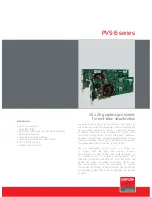
Functions of the board
APCI-3701
42
9.4
Secondary circuit
The incoming measuring signals are driven through 2 separate 8:1 multiplexers.
Each input level is then amplified by a programmable amplifier. The measuring
signal is driven through analogue filters (pass band filters) with edge frequencies
of 500 Hz and 32 kHz and acquired simultaneously with the feedback signal
(return line signal) in the A/D converter.
9.4.1
Measurement of the supply signal
The signal generated by the power buffer (OSC+ and OSC-) is returned from the
transducer to the board through the return lines Back+ and Back-. The exciting
signal is directly measured at the sensor. A precise control of the amplitude on the
primary circuit is hence not required.
A phase correction is predefined on the board to balance the phase difference
between the exciting signal of the primary circuit and the measuring signal of the
secondary signal.
9.4.2
A/D converter
The onboard converter is a 16-bit delta-sigma stereo A/D converter. This enables
to measure the measuring signal and the return line signal simultaneously.
The synchronising of the sinus signal with the master clock of the A/D converter
allow the simultaneous sampling of the measuring signal and of the return line
signal always at the same measuring points.
The A/D converter is operated in the bipolar mode. Conversion of the analog
values into digital code is carried out according to the second complement. This
means that the MSB is set to logic "1" for a negative voltage. The core of the
measuring bolt is moved inwards into the transducer. For voltages equal or
superior to 0V the MSB is set to logic "0". The core of the measuring bolt is
moved outwards out of the transducer.















































